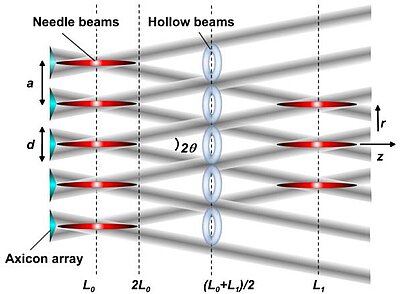1.2 Ultrafast Laser Physics and Nonlinear Optics
Project coordinators: G. Steinmeyer , T. Nagy , G. M. RossiTemporal self-imaging of arrays of nondiffracting few-cycle wavepackets
Adaptive shaping of structured ultrafast wavepackets is implemented with spatial light modulators and low-dispersion axicons based on MEMS (micro-electro-mechanical systems). Spatio-temporal propagation characteristics are analyzed by spatially resolved nonlinear autocorrelation. Recently, temporal self-imaging of arrays of needle beams (i.e. central lobes of ultrashort-pulsed Bessel beams) was demonstrated for the first time [1]. Figs. 1,2 show the experimental geometry and results.
Fig. 1: Nondiffractive or geometrical Talbot effect as periodical constructive interference behind an array of axicons of (a = period, d = element diameter, θ = half-conical beam angle, schematically). Needle beams and ring-shaped hollow beams appear alternatingly (L0: intensity maxima of first focal zones, L1: first nondiffractive Talbot distance; (L0+L1)/2: hollow beams with dark central regions) [1].
Experiments were performed with pulses from a Ti:sapphire oscillator (Venteon, initial pulse duration 6.6 fs). Arrays of needle beams were shaped by a liquid-crystal-on-silicon (LCoS) spatial light modulator (HoloEye, 1 Mpx). The two-dimensional second-order autocorrelation was detected by an EMCCD camera (iXon, Andor). Illumination was performed at large angles (< 50°) with ellipticity correction. Measurements of the nonlinear autocorrelation at three different distances show only a slight rise of the pulse duration (Fig. 2). After a propagation distance of 195 mm, the self-image in the second nondiffractive Talbot plane has a pulse duration of 8.3 fs which is still related to a sub-3-cycle pulse.
Fig. 2: Temporal self-imaging of few-cycle pulses demonstrated by spatially resolved autocorrelation at nondiffractive Talbot planes behind a hexagonal array of programmed axicons (d = 230 µm, a = 445 µm). Intensity profiles (left) and 2nd order autocorrelation (right) are shown for dark rings at (L0+L1)/2 = 60 mm (a,b), first nondiffractive Talbot distance L1 = 105 mm (c,d), and second nondiffractive Talbot plane L2 = 195 mm (e,f) [1].
Non-diffracting self-imaging allows for (a) generating distant focused undistorted ultrashort pulses well beyond the Rayleigh ranges of single focused pulses, and (b) a periodical pulse refocusing. In contrast to classical space-time focusing schemes, the pulse duration remains largely conserved whereas the intensity is found to be periodically modulated. Nondiffractive self-images of amplitude-modulated wavepackets are generated with angular-dependent time delay between the Talbot planes. Thus, the axial positions of self-images and the time scale of subsequent focusing can be tuned with adaptive axicon arrays. Specific self-imaging effects of arrayed orbital angular momentum pulses are the subject of current investigations [2].
Search publications of MBI
Publications since 2025

